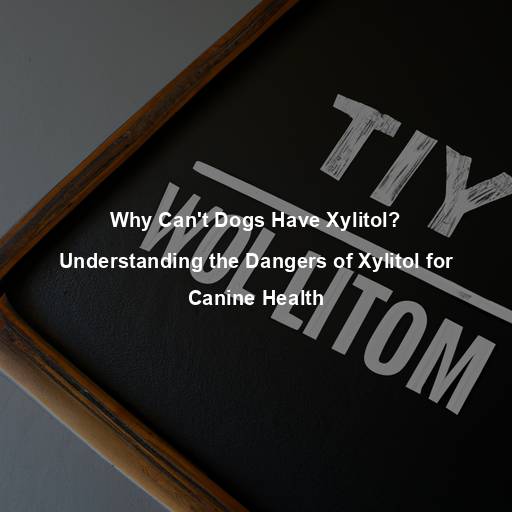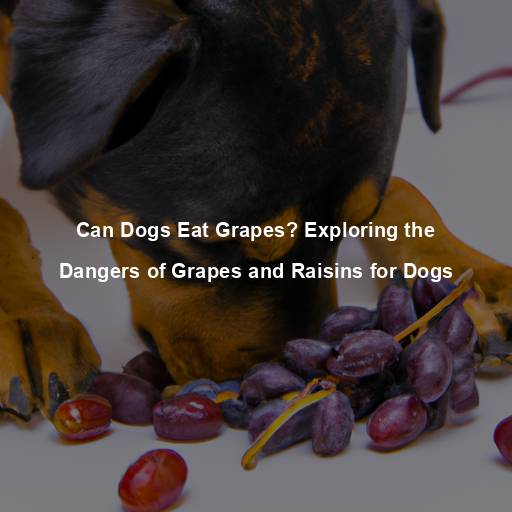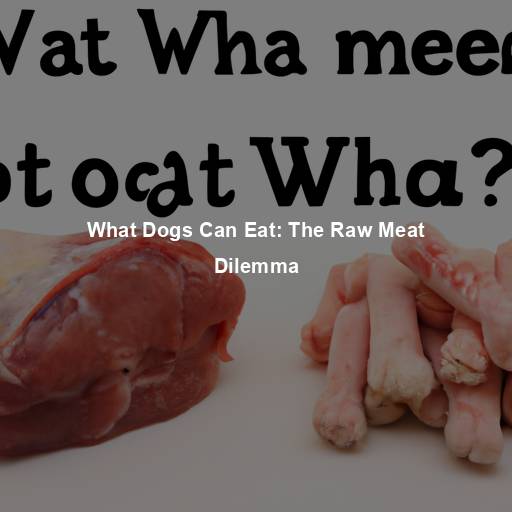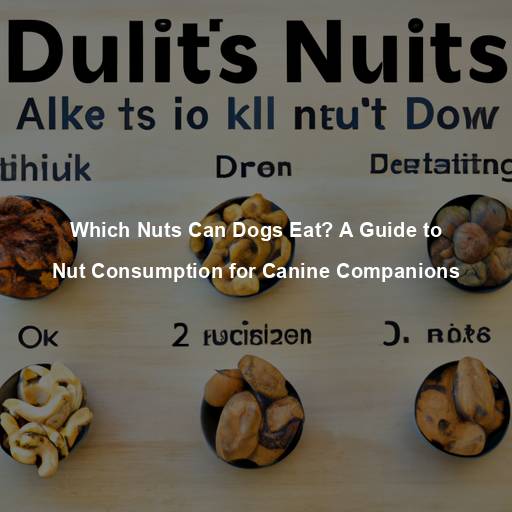Why Can’t Dogs Have Xylitol? Understanding the Dangers of Xylitol for Canine Health
Last Updated on October 26, 2023 by Evan
Contents
- 1 The Rising Concern: Xylitol and Dogs
- 1.1 Understanding Xylitol: A Sweetener with a Dark Side
- 1.2 The Doggy Dilemma: Why Xylitol is Toxic to Dogs
- 1.3 The Lethal Dose: How Little is Too Much?
- 1.4 Common Culprits: Where Xylitol Hides
- 1.5 Signs and Symptoms: Recognizing Xylitol Toxicity
- 1.6 Treatment and Management: Acting Fast Saves Lives
- 1.7 Prevention is Key: Keeping Dogs Safe
- 1.8 The Unbreakable Bond: Protecting Our Canine Companions
- 1.9 Dental Care Products
- 1.10 Medications and Supplements
- 1.11 Baked Goods and Peanut Butter
- 1.12 Chewing Gum and Candies
- 2 The Devastating Effects: Symptoms of Xylitol Poisoning
- 3 Seeking Lifesaving Treatment: What to Do in an Emergency
- 4 A Lesson in Prevention: Safeguarding our Canine Companions
- 5 The Power of Awareness: Protecting our Canine Companions
- 6 FAQs: Why can’t dogs have xylitol
- 6.1 What is xylitol?
- 6.2 Why is xylitol harmful to dogs?
- 6.3 What are the common symptoms of xylitol poisoning in dogs?
- 6.4 How much xylitol is toxic to dogs?
- 6.5 Are all dogs equally sensitive to xylitol?
- 6.6 What should I do if my dog consumes xylitol?
- 6.7 Can dogs consume any products with xylitol?
- 6.8 Can xylitol be used in dog-friendly products?
- 6.9 Are there any alternative sweeteners safe for dogs?
The Rising Concern: Xylitol and Dogs
In today’s health-conscious world, the rise of sugar substitutes has been astonishing. One particular sweetener, known as xylitol, has gained significant traction in various consumer products. Though considered a healthier option for us humans, the perplexing truth is that it poses a grave danger to our furry friends. Yes, you guessed it right – dogs!
Understanding Xylitol: A Sweetener with a Dark Side
Nowadays, one can stumble upon the peculiar-sounding name “xylitol” quite frequently. This natural sugar alcohol, derived from the depths of various fruits and vegetables, has managed to find its way into a wide array of everyday products, ranging from delightful confections to essential medications. The allure of xylitol lies in its ability to stand in as a sweetener, a remarkable feat given its low glycemic index and oral hygiene perks. However, amidst this seemingly innocent revolution, a baffling twist emerges – xylitol’s deceptive charm dissolves entirely when it comes to man’s best friend, as it poses a grave threat to dogs, taking on a sinister and disastrously detrimental effect.
The Doggy Dilemma: Why Xylitol is Toxic to Dogs
Xylitol, a seemingly innocuous sweetener, sends canine bodies into a whirlwind of perplexity. When consumed by our furry friends, it sets off a chaotic chain reaction, unleashing a burst of insulin that swiftly plummets their blood sugar levels into treacherous depths – a condition known as hypoglycemia. Within mere moments, unsuspecting pups may find themselves besieged by weakness, confusion, convulsions, and a dreadful dance with coma. In dire circumstances, the toxicity of xylitol can claim innocent lives, unless swift and decisive measures are taken.
The Lethal Dose: How Little is Too Much?
When it comes to xylitol and our furry friends, things can quickly go awry. The dosage that can be considered toxic for dogs is a slippery slope, where size and sensitivity play a perplexing role. A mere 0.1 grams per kilogram of body weight can tip the scales towards danger, while 0.5 grams per kilogram or beyond can lead to a bewildering fatality. To add some context, envision a single stick of gum with its hidden xylitol, lurking around the one gram mark, poised to unleash harm upon our pint-sized companions.
Common Culprits: Where Xylitol Hides
To safeguard our furry companions, it is crucial to be aware of the various products that may contain xylitol. While chewing gum is widely known to be a source of xylitol, it is essential to recognize that this sweetener can also be found in other unexpected items, including breath mints, candies, peanut butter, toothpaste, and certain medications. Always read labels carefully and be cautious when introducing new products into your dog’s environment.
Signs and Symptoms: Recognizing Xylitol Toxicity
It’s crucial to be alert to the subtle warning signs of xylitol poisoning in our beloved furry friends. Initially, dogs may display a puzzling combination of weariness, queasiness, coordination issues, and an unsteady walk. However, as the ailment advances, its manifestations can become even more bewildering – from convulsions and sudden collapses to an overall subdued demeanor. If you suspect that your four-legged companion has encountered xylitol or if any troubling indicators emerge, it’s imperative to prioritize swift veterinary attention.
Treatment and Management: Acting Fast Saves Lives
If your dog has ingested xylitol, time is of the essence. Contact your veterinarian or a pet poison helpline immediately for guidance. In cases of xylitol toxicity, the primary goal is to stabilize the dog’s blood sugar levels and manage any additional symptoms. Treatment may involve inducing vomiting, administering activated charcoal to prevent further absorption, intravenous fluids, and close monitoring.
Prevention is Key: Keeping Dogs Safe
Ensuring the safety of our beloved four-legged friends is of paramount importance, particularly when it comes to warding off the perils of xylitol poisoning. To navigate this perplexing and potentially hazardous situation, it is crucial to remember a few indispensable guidelines worth adhering to. By proactively adopting preventative measures and arming ourselves with knowledge, we can effectively shield our canine companions from the potentially devastating consequences of xylitol ingestion.
When it comes to keeping your furry friend safe and healthy, reading labels is a crucial step. It’s important to be on the lookout for any potential presence of xylitol in the ingredient list of the food, treats, or medications you are considering for your dog. By being diligent in this matter, you can ensure that you are not unknowingly exposing your canine companion to this potentially harmful substance. Stay informed and keep your pet’s well-being at the forefront of your choices.
In a world where our furry friends constantly captivate us with their cuteness, there’s a hidden danger lurking amongst our everyday trash – xylitol. This mysterious substance, found in various products, can pose a serious threat to our beloved dogs if not handled with utmost caution. As responsible pet owners, it’s essential to dispose of xylitol-containing items in a secure manner, far away from the curious paws and wagging tails of our canine companions. Let’s join forces in keeping our garbage safe and protecting our furry family members from the perplexing danger that lies within.
Spread awareness and knowledge to those around you – from loved ones to the ones who care for your furry friends – about the potential hazards of xylitol and emphasize the crucial need to keep it out of reach from dogs. Educating others can significantly contribute to ensuring the safety and well-being of our beloved canine companions.
When it comes to keeping our furry friends healthy, every little choice matters. So, why not go the extra mile and opt for pet-safe alternatives? From toothpaste to treats, make sure to choose products that do not contain xylitol, a sweetener that can be harmful to our canine companions. By making this simple switch, you’ll be providing your pets with the love and care they deserve, while also eliminating any potential risks.
In today’s world, it’s crucial to keep your guard up at all times. Whether you’re strolling through a bustling city or enjoying a sunny day at the local dog park, unexpected dangers may lurk in the most innocent places. Stay alert and be mindful of discarded gum or candies, as seemingly harmless objects can unexpectedly become potential hazards. Your safety is in your hands, so remain vigilant and take every precaution to protect yourself in public spaces.
The Unbreakable Bond: Protecting Our Canine Companions
Our furry friends bring immeasurable joy to our lives, and their safety is paramount. Understanding why dogs cannot have xylitol empowers us as responsible pet owners to make informed choices and protect them from potential harm. By being vigilant, knowledgeable, and proactive, we can ensure that our beloved dogs live long, healthy lives, free from the danger of xylitol toxicity.
Please note that this article is for informational purposes only and should not replace professional veterinary advice. If you suspect your dog has ingested xylitol or any other toxic substance, consult your veterinarian immediately.## The Sneaky Substitute: Xylitol in Everyday Products
Did you know that xylitol, a sweetener commonly found in sugar-free gum, can also be present in unexpected places? It’s important to stay vigilant and know the potential sources of xylitol to avoid any accidental ingestion by our furry friends. Let’s dive into the perplexing world of everyday items that may contain this hidden danger for dogs.
Dental Care Products
Taking care of our furry friends’ dental health is of utmost importance, but we must be cautious when selecting oral care products. It’s imperative to avoid human toothpaste brands that may contain xylitol, a substance that can be highly dangerous if ingested by our canine companions. Instead, choose toothpaste specifically designed for dogs, ensuring their safety even if accidentally consumed.
Medications and Supplements
Xylitol can sometimes be present in medications, both prescription and over-the-counter, as well as supplements. Always read the packaging and consult with your veterinarian to ensure that any medications or supplements you give your dog are xylitol-free.
Baked Goods and Peanut Butter
Baked goods, particularly those labeled as sugar-free or low-sugar, may contain xylitol as a sweetener. It is crucial to keep these items out of your dog’s reach, as even a small amount can be dangerous. Additionally, some brands of peanut butter may include xylitol as an ingredient. Double-check the labels and opt for xylitol-free peanut butter when giving your dog a treat.
Chewing Gum and Candies
Chewing gum and candies remain the most well-known sources of xylitol. Even a single piece of gum can contain a toxic dose for a small dog. Be cautious when disposing of gum and ensure that it is out of your dog’s reach to prevent any accidental ingestion.
The Devastating Effects: Symptoms of Xylitol Poisoning
Recognizing the signs and symptoms of xylitol poisoning is crucial for early intervention and treatment. The effects of xylitol toxicity can vary depending on the amount ingested and the size of the dog.
Early Symptoms
In the initial stages of xylitol poisoning, dogs may display signs of lethargy, vomiting, loss of coordination, and a staggering gait. These symptoms may develop within 15-30 minutes of ingestion and should never be ignored.
Hypoglycemia
One of the most dangerous consequences of xylitol ingestion is the rapid drop in blood sugar levels, known as hypoglycemia. This can lead to weakness, disorientation, seizures, and even coma. It is crucial to seek immediate veterinary care if you suspect your dog has ingested xylitol and notice any signs of hypoglycemia.
Liver Failure
In severe cases, xylitol toxicity can progress to liver failure. This occurs when the dog’s liver becomes overwhelmed by the toxic effects of xylitol, leading to a breakdown of liver cells. Symptoms of liver failure may include jaundice (yellowing of the skin and eyes), dark-colored urine, abdominal pain, and bleeding disorders. Immediate veterinary attention is vital to increase the chances of a positive outcome.
Seeking Lifesaving Treatment: What to Do in an Emergency
When it comes to your furry companion and a potential case of xylitol ingestion, it’s crucial to trust your instincts. If you sense something amiss or notice any peculiar symptoms, don’t hesitate to take swift action. Remember, time is of the utmost importance in dealing with xylitol poisoning, and seeking immediate veterinary assistance can play a pivotal role in the final outcome. Stay vigilant and prioritize your pet’s well-being.
Contact Your Veterinarian
When an emergency strikes and your furry companion becomes the unwitting victim, it’s crucial to reach out to either your trusted veterinarian or the reputable pet poison helpline without skipping a beat. Make sure to offer them a full account of the incident, leaving no stone unturned, from the extent of the xylitol exposure to every minute detail of your dog’s symptoms. In doing so, you allow them to unravel the enigma and expertly guide you through the perplexing labyrinth of what comes next, ensuring your cherished friend receives the utmost care and attention they need.
Do Not Induce Vomiting Without Professional Guidance
While inducing vomiting may be recommended in some cases of poisoning, it is crucial not to attempt this without specific instructions from a veterinarian. In the case of xylitol toxicity, vomiting may not be effective or could even worsen the situation. Always seek professional advice before attempting any home remedies.
Emergency Treatment and Monitoring
When your furry friend finds themselves in the caring hands of a veterinary clinic, rest assured that they will receive prompt and crucial medical assistance. The treatment approach will encompass a variety of measures, ranging from the stabilization of blood sugar levels to the administration of activated charcoal, a substance designed to hinder the continued absorption of xylitol. Intravenous fluids will offer hydration, while liver protectants will shield the vital organ from harm. Throughout the process, constant vigilance and attentive monitoring will guide the veterinarian in devising a personalized treatment plan that best addresses the unique challenges posed by xylitol toxicity.
A Lesson in Prevention: Safeguarding our Canine Companions
Prevention is the key to keeping our dogs safe from xylitol poisoning. By being proactive and taking necessary precautions, we can significantly reduce the risk of accidental ingestion.
Educate Yourself and Others
It’s crucial to keep yourself updated on the various sources where xylitol can lurk and spread the word among your loved ones. Educating friends, family, and even those entrusted with caring for your furry friends about the hazards of xylitol is indispensable. By fostering awareness and understanding, we pave the way for preventing unfortunate accidents from taking place.
Read Labels Diligently
It’s an absolute must to read those tiny (often perplexing) labels on doggo goodies and meds before offering them to your beloved fur baby. Take a keen eye for any hints of xylitol lurking in the ingredient list – this sneaky culprit is a big no-no for your pup’s well-being. When in doubt, it’s always a smart move to consult your trusty veterinarian or choose an alternative without that vexing xylitol.
Secure the Environment
Ensure that xylitol-containing products, such as chewing gum, candies, and baked goods, are stored securely, out of your dog’s reach. Be mindful of where you dispose of such items to prevent accidental ingestion from the trash.
Choose Safe Alternatives
When it comes to products like toothpaste and peanut butter, opt for those specifically formulated for dogs. There are numerous pet-friendly options available that do not contain xylitol, ensuring your dog’s safety while still enjoying these treats.
Stay Vigilant
In today’s world, it’s crucial to maintain a hyper-aware mindset, both within the comforts of our own homes and while venturing into public realms. Amidst the unpredictable tapestry of sidewalks and parks, a realm where surprises lurk at every turn, it is paramount to exercise utmost caution. Be ever-vigilant, for the remnants of carelessly abandoned gum or sweets may beckon our curious canine companions, leading them down a perplexing path of potential dangers. Stay alert, for the safety of both our furry friends and the serenity of our shared spaces rely on our watchful eyes and steadfast presence.
The Power of Awareness: Protecting our Canine Companions
As dog owners, it is essential that we delve into the perplexing world of why xylitol is a big no-no for our furry companions. By staying well-informed about this sneaky substance, we can embrace a proactive approach in safeguarding our beloved pets from the perils of xylitol poisoning. Equally important is our ability to decipher the enigmatic signs that may indicate our dogs have ingested this treacherous ingredient. When in doubt, remember to swiftly seek the guidance of veterinary professionals, as their expertise can help navigate the bewildering landscape of toxic substances.
FAQs: Why can’t dogs have xylitol
What is xylitol?
Xylitol is a naturally occurring sugar alcohol that is often used as a sugar substitute in various products. It is commonly found in sugar-free chewing gums, candies, baked goods, and some medications. Xylitol is known for its sweet taste and is considered safe for human consumption.
Why is xylitol harmful to dogs?
While xylitol may be safe for humans, it can be extremely toxic to dogs. When dogs consume foods or products containing xylitol, it rapidly stimulates the release of insulin from their pancreas. This insulin release can cause a sudden and dangerous drop in blood sugar levels, leading to a condition called hypoglycemia. Additionally, xylitol can also cause damage to a dog’s liver, which can be life-threatening.
What are the common symptoms of xylitol poisoning in dogs?
If a dog ingests xylitol, they might exhibit various symptoms such as vomiting, loss of coordination, lethargy, weakness, seizures, collapse, and in severe cases, even coma or death. It is crucial to seek immediate veterinary care if you suspect your dog has consumed anything containing xylitol.
How much xylitol is toxic to dogs?
The impact of xylitol on dogs is determined by their weight and the quantity consumed, with just 0.1 grams per kilogram of body weight being enough to trigger a severe response. It’s crucial to note that the levels of xylitol differ across various products, meaning that even a minuscule fragment of chewing gum or a solitary sugar-free treat can pose a threat to a dog’s well-being. Therefore, pet owners must exercise extreme caution and be mindful of this potentially hazardous ingredient in their furry friend’s surroundings.
Are all dogs equally sensitive to xylitol?
When it comes to xylitol, it’s important to remember that each furry companion is unique. While one pup may have a severe reaction to even the smallest amount, another might handle slightly larger doses without issue. Nevertheless, it’s crucial to recognize that xylitol is universally deemed highly toxic for dogs, meaning even a mere hint should ring alarm bells. Stay on the safe side and prioritize your furry friend’s well-being above all else.
What should I do if my dog consumes xylitol?
If your dog consumes a product containing xylitol, it is essential to act quickly. Contact your veterinarian or an emergency veterinary clinic immediately for advice. It may be necessary to induce vomiting or provide other emergency treatment to prevent serious complications. Do not attempt home remedies without professional guidance.
Can dogs consume any products with xylitol?
It’s an absolute no-no for our furry friends to indulge in anything with xylitol. Be sure to give those food labels a thorough scan before sharing any human treats or medicines with your beloved pooch. And hey, don’t forget to reach out to your vet for some expert advice on fido’s menu and any potential risks that might lurk around. Safety first, folks!
Can xylitol be used in dog-friendly products?
Xylitol should only be used in products explicitly made for dogs and under veterinary supervision. Some veterinary dental products and oral rinses designed for dogs may contain xylitol in safe quantities. However, it is always advisable to consult with a veterinarian before using any products that contain xylitol for your dog’s oral hygiene.
Are there any alternative sweeteners safe for dogs?
While xylitol is dangerous for dogs, there are alternative sweeteners that can be safely used in moderation. Natural sweeteners like stevia or small amounts of honey can be suitable options if used responsibly. However, it is still important to limit the amount of sweet treats and monitor your dog’s overall sugar intake to maintain a healthy diet. Always consult with your veterinarian for specific guidance on feeding your dog anything outside of their regular diet.






